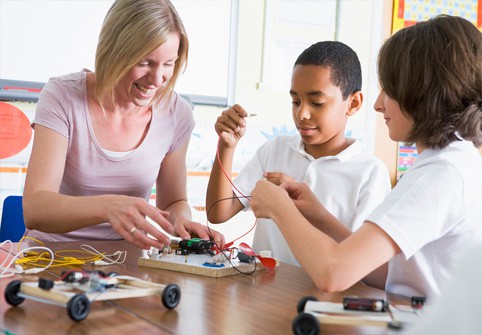For The Ambivalent Student: Four Projects to Get Them Interested In School

Even the most ambivalent child can take an interest in school if you utilize the right techniques. One way to get a child interested in learning is to incorporate projects that they will be interested in. The following four projects will help an ambivalent student take an interest in school and learning.
Goop
All kids love playing with interesting materials. Since Goop is easy to make it is an excellent project choice for students. To make Goop mix 1 teaspoon of Borax with 1/3 of a cup of warm water in a bowl. In a separate bowl, mix together 1/6 of a cup of white glue and 1/6 of a cup of water. Mix in 3 teaspoons of the Borax mixture into the glue. Knead the mixture with your hands. Students can then mold their Goop into a ball or whatever shape that they like.
Dancing Slime
Music and dancing will get even the most ambivalent child interested in school. To conduct the Dancing Slime Project, first mix together 2 cups of cornstarch and 1 cup of water to make the slime. Put the slime onto a cookie sheet. Place the cookie sheet on top of a speaker. Turn the radio on with the bass set to high. Watch as the slime dances around on the cookie sheet. You can experiment with the dancing slime by turning down the volume or changing the treble or bass settings.
Bacteria Is All Around Us
Most kids would be shocked to realize that bacteria are all around us, even in our food. In the Bacteria Is all around us project, have each student place a drop of yogurt onto a slide. Then have them put a drop of water onto the slide and place a cover slip over it. Have them look through the microscope, such as premium grade student microscopes, to see the bacteria. Let them do this with several different types of yogurt so that they can see that some of them may have more bacteria than others.
Take Flight
Learning about airplanes and flying are a great way to get kids interested in learning. To begin the Take Flight project, show kids how to make an airplane out of paper. Give them paper, glue, sequins, scissors and crayons so that they can make their plane any way they wish. Once everyone is done, have them stand at the back of the room and throw their airplanes one at a time. After each child has thrown their airplane, have them measure it to see how far it went. Once everyone has had a turn, talk about what factors they think contributed to how far the planes went.
Annette Hazard is a freelance writer that has written about parenting in the past. She is also a mother of one and an avid cyclist.







0 Comments
Leave a Comment
Your email address will not be published. All fields are required.